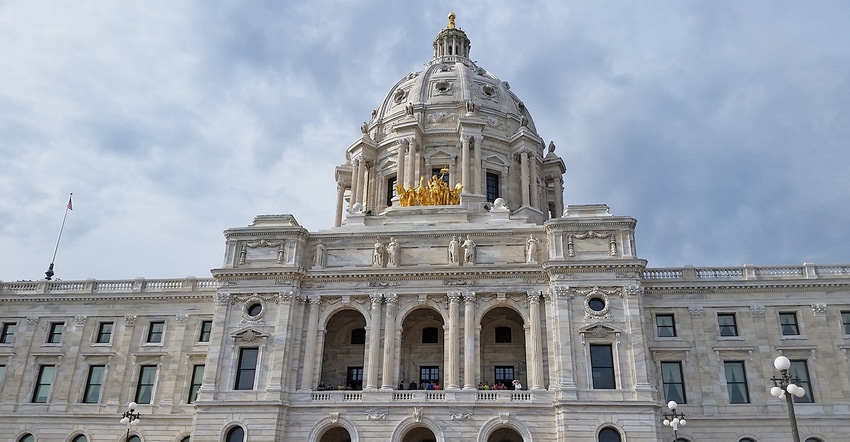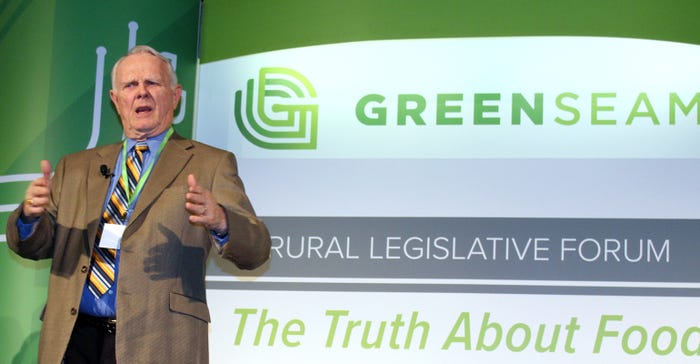
The rural-urban divide was on display during a legislative panel at the 36th annual Rural Legislative Forum Dec. 6 in Mankato, Minn., with legislators at one point using the term “Lesser Minnesota” to refer to the metropolitan area.
The area outside the Minneapolis-St. Paul metropolitan area is sometimes referred to as outstate Minnesota or Greater Minnesota, which is the term used by the three panelists: state Reps. Jeanne Poppe, DFL-Austin; Gene Pelowski, DFL-Winona; and Paul Torkelson, R-Hanska.

KEYNOTE SPEAKER: Harry Stine, CEO of Stine Seed, spoke at the 36th annual Rural Legislative Forum, held Dec. 6 at the Verizon Center in Mankato, Minn. Nearly 220 people attended the event, which also included a legislative panel and updates on farm policy. (Photo by Janet Kubat Willette)

Gov-elect Tim Walz, DFL, has coined the term ‘One Minnesota” to describe his vision for Minnesota.
The three emphasized the need for improvements in infrastructure, including not only roads and bridges, but also water and wastewater, and they discussed a variety of other topics. They didn’t delve into how to pay for the needed improvements.
Here are some highlights from the discussion.
• Pelowski, incoming chairman of the Greater Minnesota Jobs and Economic Development Finance Division, said he is encouraging Walz to hold his State of the State outside the capital. He said the visits are a great way to spotlight an industry and generate economic development. In 1988, then-Gov. Rudy Perpich traveled to Winona to deliver the first State of the State address outside the capital. His address focused on Winona’s composite engineering industry and rural economic development. Today, Winona State University has the nation’s only undergraduate composite engineering program, and Winona’s composite industry continues to be a vital part of the region’s economic base. In 2005, then-Gov. Tim Pawlenty traveled to Rochester to deliver his State of the State address. He backed a four-year university in the city, and the University of Minnesota-Rochester has since been created. Pelowski also floated the idea of holding mini-sessions in Greater Minnesota. “We are a vital part of this state,” he said.
• Torkelson said legislators won’t be able to fix tax conformity in time for this year’s taxes, so filers should allow extra time to prepare their taxes.
• Regarding the state budget, Pelowski urged caution, saying the 2% health care provider tax is due to sunset in 2020, which will leave a budget hole. The money has covered the costs of medical assistance. Before legislators spend money, they need to understand commitments, he said.
• Poppe agreed, saying legislators need to pay attention to the needs of Minnesotans. One of those needs, she said, is rural mental health care. Ted Matthews, director of mental health outreach for the Minnesota Department of Agriculture, is the only person providing mental health services targeted specifically to farmers.
• Regarding transportation, all three legislators said there is need for improvements — not only in the congested metropolitan area, but also in rural areas. Pelowski shared a story of a grocery store owner losing $70,000 in revenue in one day, when the bridge in Winona closed in 2007.
• Poppe said agricultural education should be taught in every school. “I do think food is kind of a unifier,” she said. Agricultural or food courses could be a bridge between rural and urban areas.
• Pelowski proposed that every high school senior in Minnesota graduate with employable skills. Higher education and K-12 need to rethink what they’re doing, he said.
• No agricultural forum would be complete without discussion of buffers along bodies of water, and this one was no exception. Torkelson said he’s ready to work on a buffer strip tax credit bill but is not yet ready to endorse any proposals. Poppe indicated support for a buffer strip tax credit.
Minnesota’s 2019 legislative session convenes at noon Jan. 8. Minnesota has the only split Legislature in the nation, with Democrats controlling the House and Republicans controlling the Senate.
4 tips from Harry Stine
Iowa’s 1973 Outstanding Young Farmer was the keynote speaker at this year’s Rural Legislative Forum in Mankato.
Harry Stine, CEO of Stine Seed Co., the largest independent seed company in the United States, shared a little of what he’s learned in his 77 years with the 219 individuals gathered at the Verizon Center for the 36th annual event.
Here are some of the comments he shared:
• In the 1930s, when his parents moved to Iowa, the average corn yield was 24 bushels per acre, and the plant population was 7,000 plants per acre. Today, yield is 175 bushels per acre, and plant populations vary from 30,000 to 36,000 plants per acre. Corn was 20% cob then, while today’s new hybrids are 6% to 7% cob. “Corn, incidentally, is a magic crop.”
• Farmers can save money by buying genetic versions of products.
• Education doesn’t have anything to do with intelligence.
• You get singles and doubles in plant breeding; you don’t get home runs.
Kubat Willette is a digital content creator for Farm Progress.
About the Author(s)
You May Also Like




